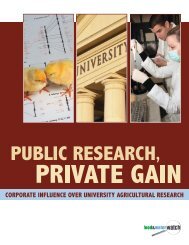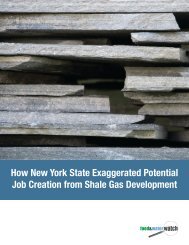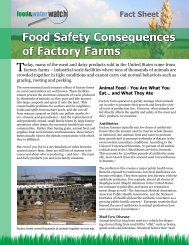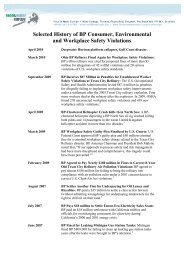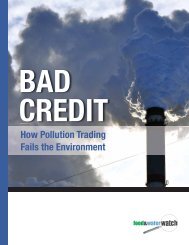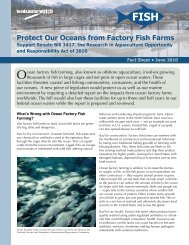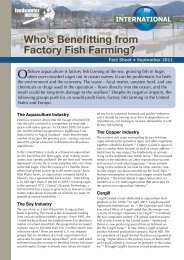Fracking, Climate Change and the Water Crisis - Food & Water Watch
Fracking, Climate Change and the Water Crisis - Food & Water Watch
Fracking, Climate Change and the Water Crisis - Food & Water Watch
Create successful ePaper yourself
Turn your PDF publications into a flip-book with our unique Google optimized e-Paper software.
<strong>Fracking</strong>,<br />
<strong>Climate</strong> <strong>Change</strong><br />
<strong>and</strong> <strong>the</strong> <strong>Water</strong> <strong>Crisis</strong><br />
<br />
Despite <strong>the</strong> alarming water crisis <strong>the</strong> world is facing, private interests are polluting, exploiting<br />
<strong>and</strong> selling water — a resource essential for all life. A 2009 publication, sponsored by <strong>the</strong><br />
World Bank’s International Finance Corporation <strong>and</strong> several for-profit multinational companies,<br />
predicted that by 2030 global freshwater dem<strong>and</strong> would exceed available supplies by 40 percent. 1<br />
In addition to <strong>the</strong> increasing pollution <strong>and</strong> overuse of <strong>the</strong> available freshwater supply, climate<br />
change will exacerbate water shortages worldwide. In fact, a UN-<strong>Water</strong> report said, “…climate<br />
change is expected to account for about 20 percent of <strong>the</strong> global increase in water scarcity.” 2<br />
Yet <strong>the</strong> oil <strong>and</strong> gas industry continues to contribute to climate<br />
change <strong>and</strong> <strong>the</strong> water crisis by drilling <strong>and</strong> fracking for fossil fuels<br />
<strong>and</strong> siphoning off <strong>the</strong> water in our aquifers <strong>and</strong> watersheds. <strong>Water</strong><br />
resources need to be protected, <strong>and</strong> <strong>the</strong> public’s best interest<br />
should be put before <strong>the</strong> interests of multinational corporations.<br />
<br />
Fossil fuel emissions are <strong>the</strong> leading source of climate-altering<br />
greenhouse gases from human activity. 3 Hydraulic fracturing,<br />
or “fracking,” is a process that <strong>the</strong> oil <strong>and</strong> gas industry uses to<br />
extract natural gas <strong>and</strong> oil from shale rock formations buried deep<br />
within <strong>the</strong> Earth. 4 On a global scale, drilling <strong>and</strong> fracking result in<br />
significant greenhouse gas emissions, 5 which threaten <strong>the</strong> climate<br />
on which we depend. 6<br />
<strong>Climate</strong> <strong>Change</strong> <strong>and</strong> Human Activity: Many greenhouse gases<br />
exist naturally in our atmosphere <strong>and</strong> are crucial for keeping <strong>the</strong><br />
planet habitable. At <strong>the</strong>se natural levels, greenhouse gases trap<br />
<strong>and</strong> absorb some energy from solar radiation within <strong>the</strong> atmo-
sphere <strong>and</strong> emit <strong>the</strong> rest back to space. 7 This process, called <strong>the</strong><br />
greenhouse effect, keeps our planet warm; 8 without it, <strong>the</strong> Earth<br />
would freeze. 9<br />
However, since <strong>the</strong> time of <strong>the</strong> Industrial Revolution, human<br />
activity has increased <strong>the</strong> amount <strong>and</strong> type of greenhouse gases<br />
entering <strong>the</strong> atmosphere. 10 The increased concentration is intensifying<br />
<strong>the</strong> greenhouse effect by making layers of greenhouse gases<br />
thicker, trapping more heat, <strong>and</strong> releasing less energy back to <strong>the</strong><br />
atmosphere. As a result, <strong>the</strong> climate is getting hotter. 11 In <strong>the</strong> long<br />
term, our planet cannot accommodate <strong>the</strong> current levels of greenhouse<br />
gas emissions released from human activity. 12<br />
<strong>Fracking</strong> <strong>and</strong> <strong>Climate</strong> <strong>Change</strong>: <strong>Fracking</strong> requires large quantities<br />
of water mixed with s<strong>and</strong> <strong>and</strong> toxic chemicals, which are<br />
injected underground at high pressure to crack dense rock <strong>and</strong><br />
release oil <strong>and</strong> gas. 13 Because natural gas is a relatively cleanburning<br />
fossil fuel compared to oil <strong>and</strong> coal, it has been touted as<br />
a potential bridge fuel for addressing climate change <strong>and</strong> transitioning<br />
to a future powered by low-carbon renewable energy<br />
resources. 14 However, recent studies have demonstrated that increased<br />
development of shale gas may actually accelerate climate<br />
change because large amounts of methane, a potent greenhouse<br />
gas that makes up more than 90 percent of shale gas, leak during<br />
fracking. 15<br />
Additionally, volatile organic compounds, including benzene <strong>and</strong><br />
toluene, are released during fracking <strong>and</strong> can mix with nitrogen<br />
oxide emissions from diesel-fueled vehicles <strong>and</strong> equipment to<br />
form ground-level ozone. 16 These emissions contribute to <strong>the</strong><br />
enhanced greenhouse effect <strong>and</strong> climate change.<br />
<br />
<br />
<br />
)<br />
4)<br />
<br />
<br />
<br />
)<br />
<br />
<br />
<br />
<br />
<br />
4)<br />
<br />
)<br />
<br />
<br />
Naturally occurring, but<br />
can be indirectly accelerated<br />
by human activity<br />
Naturally occurring <strong>and</strong><br />
from human activity<br />
Naturally occurring <strong>and</strong><br />
from human activity<br />
Naturally occurring <strong>and</strong><br />
from human activity<br />
Naturally occurring <strong>and</strong><br />
from human activity<br />
Naturally occurring <strong>and</strong><br />
from human activity<br />
Syn<strong>the</strong>tic, from human<br />
activity<br />
Syn<strong>the</strong>tic, from human<br />
activity<br />
Syn<strong>the</strong>tic, from human<br />
activity<br />
Syn<strong>the</strong>tic, from human<br />
activity<br />
Human activity can indirectly intensify water vapor quantities through<br />
global warming because a warmer atmosphere contains more water vapor.<br />
There is a positive feedback loop between global warming <strong>and</strong> water vapor:<br />
<strong>the</strong> warmer <strong>the</strong> temperature, <strong>the</strong> more water vapor in <strong>the</strong> atmosphere; <strong>the</strong><br />
more water vapor in <strong>the</strong> atmosphere, <strong>the</strong> warmer <strong>the</strong> temperature. Human<br />
activity can also contribute to water vapor levels through o<strong>the</strong>r greenhouse<br />
gas emissions (for instance, methane chemically alters in <strong>the</strong> atmosphere<br />
<strong>and</strong> produces a bit of water vapor as a byproduct).<br />
CO is generated from fossil fuel combustion, including vehicle emissions <strong>and</strong><br />
some manufacturing processes. Deforestation also increases CO levels.<br />
Sources of CH 4<br />
N 2O can originate from fertilizer use, various industrial processes, fossil<br />
fuels <strong>and</strong> vehicle emissions.<br />
Carbon monoxide, hydrocarbons <strong>and</strong> nitrogen oxide can chemically react to<br />
produce “bad” (tropospheric) ozone.<br />
Carbon monoxide (CO) can be considered an indirect greenhouse gas since it can<br />
control <strong>the</strong> production of o<strong>the</strong>r greenhouse gases such as ozone <strong>and</strong> methane.<br />
VOCs can get into <strong>the</strong> atmosphere from vehicle emissions, fuel production<br />
<strong>and</strong> biomass burning.<br />
CFCs come from completely syn<strong>the</strong>tic sources like aerosols <strong>and</strong> cleaning<br />
solvents <strong>and</strong> can stay in <strong>the</strong> atmosphere for more than 100 years. CFCs can<br />
deplete “good” (stratospheric) ozone<br />
CF 4 has a long atmospheric lifespan <strong>and</strong> can come from a variety of industrial<br />
processes.<br />
SF 6 has a long atmospheric lifespan <strong>and</strong> can come from a variety of industrial<br />
processes.<br />
HFCs are made from syn<strong>the</strong>tic sources <strong>and</strong> can come from a variety of<br />
industrial processes, but have a shorter atmospheric lifespan.<br />
National Oceanic <strong>and</strong> Atmospheric Administration, National Climatic Data Center. “Greenhouse Gases. Frequently Asked Questions.” Last updated February 23,<br />
2010. Accessed May 1, 2012 at http://www.ncdc.noaa.gov/oa/climate/gases.html; U.S. Environmental Protection Agency. “<strong>Climate</strong> <strong>Change</strong> – Greenhouse Gas Emissions.”<br />
Last updated February 27, 2012. Accessed May 1, 2012 at http://www.epa.gov/climatechange/emissions/index.html; Intergovernmental Panel on <strong>Climate</strong> <strong>Change</strong>. (2007.)<br />
“Frequently Asked Questions.” <strong>Climate</strong> <strong>Change</strong> 2007: The Physical Science Basis. Contribution of Working Group I to <strong>the</strong> Fourth Assessment Report of <strong>the</strong> Intergovernmental Panel<br />
on <strong>Climate</strong> <strong>Change</strong>. Cambridge University Press, Cambridge, <strong>and</strong> New York, NY, at 100 to 102.<br />
2
<strong>Water</strong> belongs to <strong>the</strong> public <strong>and</strong> should be protected <strong>and</strong> preserved<br />
for <strong>the</strong> public. 17 However, <strong>the</strong> private water industry treats water<br />
as a market-based product, <strong>and</strong> some companies are selling public<br />
water resources to <strong>the</strong> oil <strong>and</strong> gas industry. The commodification<br />
of water — i.e., treating water as a commodity — combined with<br />
fracking could contribute to water scarcity <strong>and</strong> climate change.<br />
<strong>Water</strong>-for-Profit Companies Make Money Off <strong>Fracking</strong>:<br />
Shale gas development creates a potential multibillion-dollar<br />
market for water supply <strong>and</strong> treatment services, 18 <strong>the</strong> prospect<br />
of which could be encouraging some large investor-owned water<br />
utilities to support shale gas <strong>and</strong> downplay its water risks. 19<br />
For example, during 2011, American <strong>Water</strong> — <strong>the</strong> largest publicly<br />
traded water <strong>and</strong> sewer utility in <strong>the</strong> country — sold 250 million<br />
gallons of water to a dozen gas-drilling companies, making<br />
$1.6 million in revenue. 20 It sold water at 34 distribution points in<br />
Pennsylvania, 21 mostly through pipeline extensions from its water<br />
systems. 22 The company gave gas drillers a major discount on<br />
<strong>the</strong> price of water compared to what households pay — a benefit<br />
shared by o<strong>the</strong>r large industrial water users. On average, drillers<br />
paid 45 percent less than residential customers per gallon of<br />
water. (See Table 1.)<br />
<strong>Water</strong> Commodification <strong>and</strong> Drought, A Bad Mix: In Pennsylvania,<br />
for example, <strong>the</strong> Susquehanna River Basin Commission<br />
(SRBC) grants permits to private companies so <strong>the</strong>y can withdraw<br />
<strong>and</strong> purchase water from <strong>the</strong> Susquehanna River basin for fracking.<br />
24 Many permits have been granted to oil <strong>and</strong> gas companies, 25<br />
<strong>and</strong> in March 2012 <strong>the</strong> SRBC approved a private water company’s<br />
application to withdraw millions of gallons of water to supply to<br />
drillers for fracking. 26 A month later in April, however, <strong>the</strong> commission<br />
placed a temporary moratorium on water withdrawals in<br />
certain areas due to severe drought conditions. 27 This is particularly<br />
noteworthy since shale gas fracking uses significantly more<br />
water than conventional natural gas production, 28 <strong>and</strong> unsustainable<br />
water withdrawals combined with increasing drought conditions<br />
can greatly reduce water supply. 29<br />
<br />
As a U.S. Geological Survey publication said, “The hydrologic<br />
cycle describes <strong>the</strong> continuous movement of water above, on, <strong>and</strong><br />
below <strong>the</strong> surface of <strong>the</strong> Earth.” 30 Rainfall can recharge surface<br />
<strong>and</strong> groundwater sources. Heat from <strong>the</strong> sun evaporates water<br />
back into <strong>the</strong> atmosphere as a vapor that condenses into clouds<br />
before falling again to <strong>the</strong> Earth. “<strong>Climate</strong> <strong>and</strong> freshwater systems<br />
are interconnected in complex ways,” <strong>the</strong> Intergovernmental Panel<br />
on <strong>Climate</strong> <strong>Change</strong> noted. “Any change in one of <strong>the</strong>se systems<br />
induces a change in <strong>the</strong> o<strong>the</strong>r.” 31<br />
This disparity appears to be a result from a bias in <strong>the</strong> company’s<br />
rate structure that favors large water users. Pennsylvania American<br />
<strong>Water</strong> said that it charged drillers its st<strong>and</strong>ard commercial<br />
rate <strong>and</strong> must serve any qualified applicant that requests service<br />
within its service area. Pennsylvania American <strong>Water</strong>’s natural<br />
gas drilling company customers included ALTA Operating Company,<br />
LLC; Cabot Oil & Gas Corporation; Carrizo Oil & Gas, Inc.;<br />
EOG Resources, Inc. <strong>and</strong> Rex Energy Corporation. 23<br />
IMAGE COURTESY OF U.S. GEOLOGICAL SURVEY<br />
Table 1. <br />
Comparison of Pennsylvania American <strong>Water</strong>’s Metered <strong>Water</strong> Sales to Gas Drillers <strong>and</strong> Residential Customers During 2011<br />
<br />
<br />
(in gallons)<br />
<br />
<br />
(Revenue/Volume) / ($ per 1,000 gallons)<br />
Gas Drillers a 250,400,000 $1,600,000 $6.39<br />
Residential Customers b 28,327,905,000 $329,801,618 $11.64<br />
$5.25<br />
<br />
<br />
<br />
American <strong>Water</strong>. “Institution Investor Presentation.” May 2012 at 35.<br />
Pennsylvania American <strong>Water</strong> Company. “2011 <strong>Water</strong> PUC Report for Pennsylvania American <strong>Water</strong>.” April 30, 2012 at 36 <strong>and</strong> 38.<br />
3
Unpredictable <strong>and</strong> Extreme Wea<strong>the</strong>r Events: <strong>Climate</strong> change<br />
is believed to affect <strong>the</strong> water cycle <strong>and</strong> cause more extreme<br />
wea<strong>the</strong>r events, including heat waves, floods <strong>and</strong> droughts. 32 Also<br />
becoming more common are tropical cyclones <strong>and</strong> o<strong>the</strong>r severe<br />
storms. 33 Rising ocean temperatures will lead to more rapid evaporation.<br />
34<br />
The National Oceanic <strong>and</strong> Atmospheric Administration reported<br />
that “2011 was a record-breaking year for climate extremes, as<br />
much of <strong>the</strong> United States faced historic levels of heat, precipitations,<br />
flooding <strong>and</strong> severe wea<strong>the</strong>r.” 35 For example, Tropical Storm<br />
Lee caused extreme flooding in states like Pennsylvania <strong>and</strong> New<br />
York. 36 During <strong>the</strong> first quarter of 2012, wildfires ignited along <strong>the</strong><br />
east coast from Florida to New Engl<strong>and</strong>, <strong>and</strong> 48 states experienced<br />
abnormally dry or drought conditions. 37<br />
Impacts on <strong>Water</strong> Quality <strong>and</strong> Quantity: According to a<br />
UN-<strong>Water</strong> report: “Scarcity is also a question of water quality.<br />
Freshwater bodies have a limited capacity to process <strong>the</strong> pollutant<br />
charges of <strong>the</strong> effluents from exp<strong>and</strong>ing urban, industrial <strong>and</strong><br />
agricultural uses. <strong>Water</strong> quality degradation can be a major cause<br />
of water scarcity.” 38<br />
<strong>Climate</strong> change has a bearing on water quality <strong>and</strong> quantity. It<br />
will intensify prolonged drought conditions, decrease freshwater<br />
availability <strong>and</strong> hinder groundwater recharge. 39 The warmer<br />
temperatures combined with increasingly extreme storm events<br />
<strong>and</strong> droughts will also lead to more water pollution. 40 As intense<br />
rainfall hits saturated or impervious surfaces, like roads, it cannot<br />
infiltrate <strong>the</strong> ground <strong>and</strong> instead flows overl<strong>and</strong> as stormwater<br />
runoff, picking up pollutants along <strong>the</strong> way. 41 In addition, increasing<br />
temperatures melt snowpack, ice caps <strong>and</strong> glaciers. 42 Glacial<br />
melting causes sea levels to rise, 43 which increases saltwater intrusion<br />
in many freshwater sources, reducing <strong>the</strong> amount of drinkable<br />
freshwater. 44<br />
<strong>Fracking</strong> <strong>and</strong> <strong>the</strong> commodification of water are detrimental<br />
to people <strong>and</strong> <strong>the</strong> planet. In order to help mitigate global<br />
climate change <strong>and</strong> ensure a sustainable water supply for<br />
future generations, we must ban fracking <strong>and</strong> water commodification.<br />
<br />
<strong>Water</strong> usage decisions should not be left to a market-based mechanism.<br />
To safeguard communities from water degradation <strong>and</strong><br />
shortages, we should implement integrative water <strong>and</strong> climate<br />
change policies aimed to: (1) significantly reduce <strong>the</strong> amount of<br />
greenhouse gases released into <strong>the</strong> atmosphere, <strong>and</strong> (2) sustainably<br />
manage <strong>and</strong> protect all water resources. If water is treated<br />
as a commodity, it cannot adequately be protected for current or<br />
future generations.<br />
Governments should foster adaptive water resource<br />
management. As described by <strong>the</strong> Center for Isl<strong>and</strong> <strong>Climate</strong><br />
<strong>Change</strong> Adaptation <strong>and</strong> Policy at <strong>the</strong> University of Hawai‘i,<br />
adaptive water management is shaped by policies <strong>and</strong> rules<br />
that are: “(1) forward-looking—focused on crisis avoidance as<br />
well as crisis mitigation; (2) flexible—able to adjust to changing<br />
needs <strong>and</strong> conditions; (3) integrated—able to address climaterelated<br />
impacts that cut across political <strong>and</strong> geographical<br />
boundaries; <strong>and</strong> (4) iterative—utilizing a continuous loop of<br />
monitoring, feedback, <strong>and</strong> reevaluation.” 45 Being adaptive<br />
allows water management practices to be preemptive ra<strong>the</strong>r<br />
than reactive.<br />
<strong>Water</strong> management practices should not be solely reactive.<br />
Proactive water protection provisions should support<br />
precautionary principles.<br />
All water resources should be managed under statewide<br />
commons <strong>and</strong> <strong>the</strong> public trust framework.<br />
<strong>Fracking</strong> <strong>and</strong> <strong>the</strong> commodification of common water<br />
resources must be banned.<br />
<br />
1 The 2030 <strong>Water</strong> Resources Group. “Charting Our <strong>Water</strong> Future: Economic<br />
frameworks to inform decision-making.” 2009 at i <strong>and</strong> 5.<br />
2 UN-<strong>Water</strong>. “Coping with <strong>Water</strong> Scarcity. Challenge of <strong>the</strong> Twenty-First<br />
Century.” March 22, 2007 at 15.<br />
3 Intergovernmental Panel on <strong>Climate</strong> <strong>Change</strong> (IPCC). “<strong>Climate</strong> <strong>Change</strong><br />
2007: Syn<strong>the</strong>sis Report.” 2008 at 36; U.S. Environmental Protection<br />
Agency. “Inventory of U.S. Greenhouse Gas Emissions <strong>and</strong> Sinks:<br />
1990-2010.” (EPA 430-R-12-001). April 15, 2012 at ES-6.<br />
4 American Petroleum Institute. “Freeing Up Energy. Hydraulic Fracturing:<br />
Unlocking America’s Natural Gas Resources.” July 19, 2010 at 1, 2<br />
<strong>and</strong> 4.<br />
<br />
Climatic <strong>Change</strong>, vol. 108, iss. 3. October 2011 at 601 to 607; Howarth,<br />
Robert W. et al. “Methane <strong>and</strong> <strong>the</strong> greenhouse-gas footprint of natural<br />
gas from shale formations.” Climatic <strong>Change</strong>, vol. 106. June 2011<br />
at 679; Tyndall Centre for <strong>Climate</strong> <strong>Change</strong> Research. University of<br />
Manchester. “Shale gas: a provisional assessment of climate change<br />
<strong>and</strong> environmental impacts.” January 2011 at 6.<br />
6 IPCC, 2008 at 48.<br />
7 IPCC. (2007). “Frequently Asked Questions.” <strong>Climate</strong> <strong>Change</strong> 2007: The<br />
Physical Science Basis. Contribution of Working Group I to <strong>the</strong> Fourth<br />
Assessment Report of <strong>the</strong> Intergovernmental Panel on <strong>Climate</strong> <strong>Change</strong>.<br />
Cambridge University Press, Cambridge, U.K. <strong>and</strong> New York, NY, at 98<br />
to 102; Schlesinger, William H. “<strong>Climate</strong> <strong>Change</strong>.” Interpretation, vol.<br />
65, iss. 4. October 2011 at 379 <strong>and</strong> 382.<br />
8 IPCC, 2007 at 98 to 102; Schlesinger, 2011 at 379 <strong>and</strong> 382.<br />
9 Schlesinger, 2011 at 379 <strong>and</strong> 382.<br />
10 National Oceanic <strong>and</strong> Atmospheric Administration, National Climatic<br />
Data Center. “Greenhouse Gases. Frequently Asked Questions.” Last<br />
updated February 23, 2010. Accessed May 1, 2012 at http://www.<br />
ncdc.noaa.gov/oa/climate/gases.html; IPCC, 2007 at 99; Schlesinger,<br />
2011 at 381.<br />
11 IPCC, 2007 at 99 <strong>and</strong> 100; Karl, Thomas R. et al. U.S. Global <strong>Change</strong><br />
Research Program. (2009). “<strong>Climate</strong> Impacts in <strong>the</strong> United States.”<br />
Cambridge University Press, New York, NY at 14.<br />
4
12 Schlesinger, 2011 at 381 to 383.<br />
13 American Petroleum Institute. “Freeing up energy. Hydraulic fracturing:<br />
Unlocking America’s natural gas resources.” July 19, 2010 at 1,<br />
2, <strong>and</strong> 4; Arthur, Daniel J. et al. “Hydraulic fracturing considerations<br />
for natural gas wells of <strong>the</strong> Marcellus shale.” Paper presented at The<br />
Ground <strong>Water</strong> Protection Council 2008 Annual Forum, Cincinnati,<br />
OH. September 21–24, 2008 at 8; Colborn, Theo et al. “Natural Gas<br />
Operations from a Public Health Perspective.” International Journal of<br />
Human <strong>and</strong> Ecological Risk Assessment, vol. 17, iss. 5. September 2011<br />
at 1040 to 1041; Groundwater Protection Council <strong>and</strong> ALL Consulting.<br />
“Modern Shale Gas Development in <strong>the</strong> United States: A Primer.”<br />
<br />
National Energy Technology Laboratory. April 2009 at ES-4.<br />
14 Podesta, John D. <strong>and</strong> Timothy E. Wirth. Center for American Progress.<br />
“Natural Gas: A Bridge Fuel for <strong>the</strong> 21st Century.” August 10, 2009 at<br />
1.<br />
15 Wigley, 2011 at 601 <strong>and</strong> 607; Howarth, 2011 at 679; Jackson, Robert<br />
B. et al. “Research <strong>and</strong> Policy Recommendations for Hydraulic Fracturing<br />
<strong>and</strong> Shale-Gas Extraction.” Duke University, Center on Global<br />
<strong>Change</strong>. 2011 at 2.<br />
16 Colborn, 2011 at 1042.<br />
17 Klass, Alex<strong>and</strong>ra B. <strong>and</strong> Ling-Yee Huang. Center for Progressive<br />
Reform. “Restoring <strong>the</strong> Trust: <strong>Water</strong> Resources <strong>and</strong> <strong>the</strong> Public Trust<br />
Doctrine, A Manual for Advocates.” September 2009 at 2.<br />
18 Pickrell, Emily. “<strong>Water</strong> follows <strong>the</strong> shale trail.” Global <strong>Water</strong> Intelligence,<br />
vol. 11, iss. 1. January 2010 at 25.<br />
19 See <strong>Food</strong> <strong>and</strong> <strong>Water</strong> <strong>Watch</strong>. “The Private <strong>Water</strong> Industry’s Stake in<br />
Shale Gas Development.” November 2011.<br />
20 American <strong>Water</strong> Works Company, Inc. U.S. Securities <strong>and</strong> Exchange<br />
Commission. Form 10-K. February 25, 2011 at 3; American <strong>Water</strong>.<br />
“Institution Investor Presentation.” May 2012 at 35.<br />
21 American <strong>Water</strong>, 2012 at 35.<br />
ence<br />
Call – Final.” FD (Fair Disclosure) Wire. August 4, 2011 at 3.<br />
23 Susquehanna River Basin Commission. “Approved <strong>Water</strong> Sources for<br />
Natural Gas Development.” March 30, 2011.<br />
24 Pennsylvania State University. Penn State College of Agricultural Sciences,<br />
Cooperative Extension. “<strong>Water</strong> Withdrawals for Development<br />
of Marcellus Shale in Pennsylvania.” Marcellus Education Fact Sheet.<br />
2010 at 4 <strong>and</strong> 7.<br />
25 Ibid. at 4. Susquehanna River Basin Commission, 2011.<br />
26 Thompson, David. “32-unit village no more.” Sun-Gazette (Williamsport,<br />
PA). March 18, 2012. Krize, Nikki. “State Police Confront Protestors.”<br />
WNEP 16 News Station (Scranton/Wilkes-Barre, PA). June 12,<br />
2012.<br />
27 Detrow, Scott. “SRBC Suspends <strong>Water</strong> Withdrawal in 5 Counties.”<br />
StateImpact, Pennsylvania. April 18, 2012; Prezioso, Jeanine. “Drought<br />
Reuters. April 20, 2012.<br />
28 Silverstein, Ken. “<strong>Water</strong> Shortages May Leave Energy Producers Dying<br />
of Thirst.” Forbes. May 3, 2012.<br />
29 U.S. Department of Energy, National Renewable Energy Laboratory.<br />
“The Wind/<strong>Water</strong> Nexus.” (DOE/GO-102006-2218). April 2006 at 1.<br />
30 Winter, Thomas C. et al. U.S. Department of <strong>the</strong> Interior, U.S. Geological<br />
Survey. “Ground <strong>Water</strong> <strong>and</strong> Surface <strong>Water</strong>. A Single Resource.”<br />
(Circular 1139). 1998 at 2.<br />
31 Kundzewicz, Z.W. et al. (2007). “Freshwater resources <strong>and</strong> <strong>the</strong>ir management.”<br />
<strong>Climate</strong> <strong>Change</strong> 2007: Impacts, Adaptation <strong>and</strong> Vulnerability.<br />
Contribution of Working Group II to <strong>the</strong> Fourth Assessment Report of<br />
<strong>the</strong> Intergovernmental Panel on <strong>Climate</strong> <strong>Change</strong>. Cambridge University<br />
Press, Cambridge, U.K. at 175 to 176.<br />
<br />
“<strong>Climate</strong> <strong>Change</strong> <strong>and</strong> <strong>the</strong> Global <strong>Water</strong> <strong>Crisis</strong>: What Businesses Need<br />
to Know <strong>and</strong> Do.” May 2009 at 2.<br />
<br />
Compact, 2009 at 2.<br />
34 Schlesinger, 2011 at 384.<br />
35 U.S. Department of Commerce, National Oceanic <strong>and</strong> Atmospheric<br />
Administration. [Press release]. “NOAA: 2011 a year of climate extremes<br />
in <strong>the</strong> United States.” January 19, 2012.<br />
36 Ibid.<br />
37 Rice, Doyle. “Drought exp<strong>and</strong>s throughout USA.” USA Today. April 11,<br />
2012.<br />
38 UN-<strong>Water</strong>, 2007 at 10.<br />
<br />
Global Compact, 2009 at 2.<br />
40 Kundzewicz, 2007 at 175 <strong>and</strong> 176.<br />
<br />
<br />
2012. Accessed May 3, 2012 at http://ga.water.usgs.gov/edu/watercy-<br />
<br />
Public Health Reports<br />
et al. American Rivers, American Society of L<strong>and</strong>scape Architects,<br />
ECONorthwest, <strong>Water</strong> Environment Federation. “Banking on Green:<br />
A Look at How Green Infrastructure Can Save Municipalities Money<br />
<br />
42 IPCC, 2007 at 105 to 111.<br />
43 Schlesinger, 2011 at 385.<br />
44 Kundzewicz, 2007 at 175 <strong>and</strong> 179.<br />
45 Wallsgrove, Richard <strong>and</strong> David Penn. “<strong>Water</strong> Resources <strong>and</strong> <strong>Climate</strong><br />
<strong>Change</strong> Adaptation in Hawai’i: Adaptive Tools in <strong>the</strong> Current Law <strong>and</strong><br />
Policy Framework.” University of Hawai’i, Center for Isl<strong>and</strong> Adaptation<br />
<strong>and</strong> Policy. 2012 at iii.<br />
<strong>Food</strong> & <strong>Water</strong> <strong>Watch</strong> works to ensure <strong>the</strong> food, water <strong>and</strong> fish we consume is safe, accessible<br />
<strong>and</strong> sustainable. So we can all enjoy <strong>and</strong> trust in what we eat <strong>and</strong> drink, we help people take<br />
charge of where <strong>the</strong>ir food comes from, keep clean, affordable, public tap water flowing freely to<br />
our homes, protect <strong>the</strong> environmental quality of oceans, force government to do its job protecting<br />
citizens, <strong>and</strong> educate about <strong>the</strong> importance of keeping shared resources under public control.<br />
Copyright © September 2012 by <strong>Food</strong> & <strong>Water</strong> <strong>Watch</strong>. All rights reserved. This issue brief can be viewed or downloaded at www.food<strong>and</strong>waterwatch.org.




